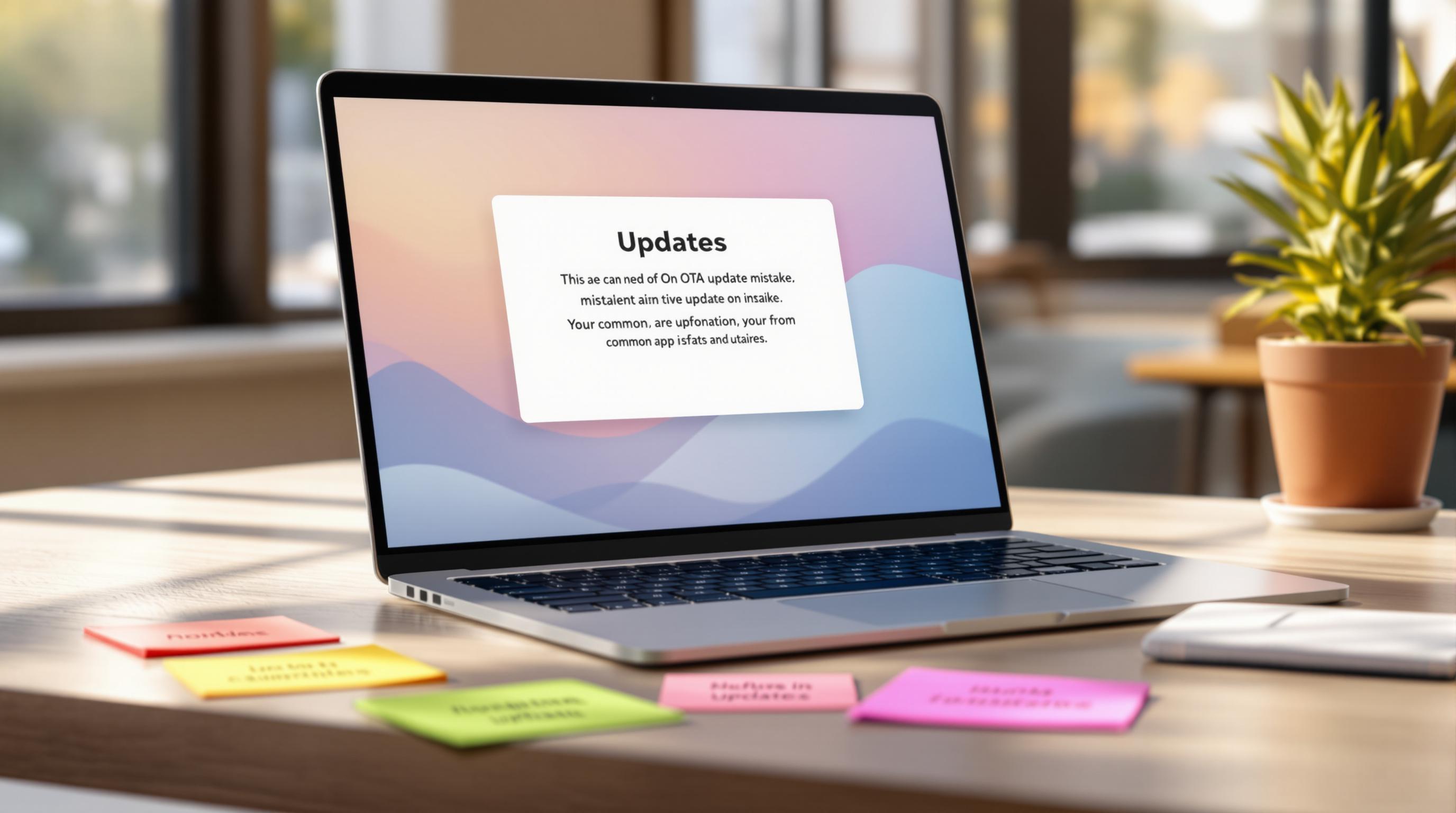CI/CD pipelines are essential for delivering over-the-air (OTA) updates quickly and efficiently. But they often face challenges that slow down deployments. Here’s what you need to know:
- Key Bottlenecks: Tool integration issues, testing delays, scalability problems, security gaps, and lack of performance tracking.
- Solutions: Automate tasks, use delta updates, implement parallel and staged rollouts, and set up rollback systems.
- Best Practices: Secure updates with encryption, track performance with real-time analytics, and ensure compliance with app store rules.
By addressing these bottlenecks, you can achieve faster updates, reduce costs, and improve user satisfaction. For example, Capgo’s platform has delivered 23.5 million updates with an 82% success rate, saving up to $26,100 over five years.
Takeaway: Streamline your CI/CD pipeline with automation, security, and smart deployment strategies to deliver OTA updates efficiently.
DevOps Pipeline SLOWING You Down? Here’s the FIX!
Major CI/CD Pipeline Slowdowns
OTA CI/CD pipelines often face bottlenecks that delay deployments, impacting efficiency and timelines.
Tool Integration Challenges
Getting development tools to work smoothly together can cause delays. Seamless integration with widely-used CI/CD platforms like GitHub Actions and GitLab CI simplifies workflows while maintaining security protocols.
“We configure your CI/CD pipeline directly in your preferred platform, whether it’s GitHub Actions, GitLab CI, or others. We don’t host CI/CD or charge you to maintain it.” – Capgo [1]
This hurdle often sets the stage for other challenges within the CI/CD pipeline.
Testing Delays
Testing phases can also slow things down, especially when automation is limited or validations are overly complex. Introducing automated, phased rollouts - like targeted beta testing - can help streamline this process and reduce delays.
Scalability Issues
As the volume of updates grows, pipelines can struggle to keep up. Managing large-scale simultaneous updates often becomes a bottleneck. Cloud-based solutions provide a way to handle this growth more effectively by improving resource allocation and scalability.
Security Concerns in OTA Pipelines
Security gaps in OTA pipelines pose risks to the deployment process. Using end-to-end encryption is critical to protect update content and ensure compliance with security standards. Modern OTA systems now rely on strong encryption to address these vulnerabilities.
Lack of Performance Tracking
Without proper performance tracking, identifying and resolving issues becomes a challenge. Real-time analytics integrated into the pipeline can provide the necessary insights to optimize workflows and address problems quickly.
Speed Up Build and Deploy Times
Make over-the-air (OTA) updates faster with smart automation and efficient deployment strategies.
Automating Pipeline Tasks
Automating repetitive tasks can save a lot of time during deployment. By setting up automated processes for integration, testing, and deployment, you can cut out manual delays. Tools like GitHub Actions and GitLab CI are great for this. Platforms like Capgo can also help by customizing your CI/CD pipeline directly on your chosen platform. To go further, use differential deployments to reduce the size of update payloads.
Using Delta Updates
Delta updates focus on sending only the parts of the software that have changed, instead of the entire package. This approach cuts down the size of updates, speeds up deployment, and reduces bandwidth consumption.
Parallel and Staged Rollouts
Speed things up by running pipeline tasks in parallel. Combine this with staged rollouts - such as beta testing, phased deployments, and eventually full production - to manage risks and reduce the strain on servers.
Adding a Rollback System
Make sure you have a rollback system in place. This allows you to quickly revert to a stable version if something goes wrong.
CI/CD Pipeline Standards
Setting clear standards is crucial for secure and compliant OTA updates.
App Store Rule Checklist
Following app store rules is a must for successful OTA updates. Both the Apple App Store and Google Play Store have strict guidelines. Capgo’s platform helps ensure compliance by using end-to-end encryption, allowing only authorized users to decrypt update packages [1].
Some important compliance requirements include:
- Secure update delivery methods
- Obtaining user consent for updates
- Clear version tracking
- Effective error handling
- Rollback options for failed updates
Complete Testing Steps
Thorough testing is critical for dependable OTA updates. A structured testing process - covering unit tests, integration tests, and end-to-end tests - helps maintain stability. Capgo’s channel system supports advanced testing by letting teams release updates to specific user groups for beta testing and staged rollouts [1].
Testing should focus on:
- Ensuring update package integrity
- Handling network connectivity issues
- Checking version compatibility
- Optimizing resource usage
- Verifying error recovery processes
Once testing is solid, monitoring the update process is the next step to quickly resolve any issues.
Update Progress Tracking
Monitoring deployments in real time is essential to ensure the pipeline runs smoothly and efficiently.
Team Communication Methods
Good communication is key for managing OTA updates. Establishing clear channels and role-based access controls can simplify the deployment process. Capgo’s organization management system aids team collaboration by allowing the creation of roles and permissions, ensuring proper oversight [1].
Best practices for communication include:
- Regular updates on deployment status
- Clear escalation procedures for issues
- Coordination protocols across teams
- Detailed documentation of deployment decisions
Conclusion
Tackling CI/CD bottlenecks is crucial for ensuring smooth OTA delivery. Streamlined pipelines can lead to impressive results, such as 95% of active users receiving updates within 24 hours, a 5MB bundle downloading in just 114ms, and an average API response time of 434ms [1].
“Capgo is a smart way to make hot code pushes” [1]
Capgo’s implementation across 750 apps with over 23.5 million updates [1] highlights the potential savings - up to $26,100 over five years - when using efficient OTA update systems. To achieve this, effective CI/CD management focuses on:
- Automated workflows to reduce manual tasks
- Delta updates to limit bandwidth usage
- Staged deployments for controlled rollouts
- Strong security with end-to-end encryption
- Real-time monitoring with detailed analytics




